A curiosity for Nordic art and culture calls audiences to The Phillips Collection.
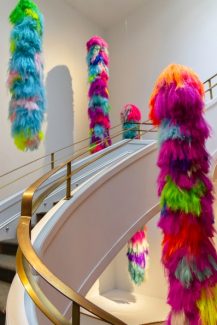
Hrafnhildur Arnardottir/ Shoplifter (. 1969, Reykjavik, Iceland); Nervelings I-V; 2018; Synthetic hair, rope.
The Phillips Collection links craft with the art of diplomacy in its latest exhibition, “Nordic Impressions.” From now until January 13, America’s first modern art museum presents a survey of the dialogue and diversity of Nordic art with a collection covering nearly 200 years and 53 artists from Denmark, Iceland, Norway, Sweden, Finland, and self-governing Greenland, Faroe Islands and Åland.
Spanning paintings, textile-inspired works and video installations, “Nordic Impressions” pays tribute to the dynamism of Northern European artists in an exhibition exclusive to the Phillips. The product of a four-year-long “Nordic Initiative”, the gallery and their Embassy Row neighbors coalesce a show that serves to expand audiences’ perceptions of the countries’ conglomerate and individual cultures.
“We are all extremely delighted by this opportunity to exhibit Nordic art to American audiences and in such a remarkable space and with such great variety.
It is [the artist’s] artistic expression that we celebrate and showcase,” says Sampo Terho, Minister for European Affairs, Culture and Sport in Finland.
An example of cultural diplomacy, “Nordic Impressions” explores modern and contemporary works through their fullest international manifestation in the nation’s multicultural capital.
Vradenburg Director and CEO of The Phillips Dorothy Kosinski prides the gallery for its ability to produce such collaborative shows. “I thank all the embassies and ambassadors for this rich collaboration that we have enjoyed for almost four years, as well as the cultural attachés who provided us with this central support through realizing this complex project.”
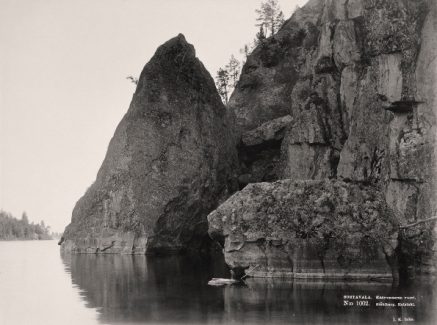
I.K. Inha (b. 1865, Virrat, Finland; d.1930, Helsinki, Finland); Sortavala, Rock of Kaarnessaari; 1895; albumen print
Designed by Chief Curator and Deputy Director of Academic Affairs, Klaus Ottmann, the show recounts his impression of Nordic art, highlighting famous artists and observed themes carried out in the pieces; hence, the exhibition’s namesake. The title foretells this is not a conclusive exhibition of Nordic art.
They are impressions. Like the artists that influence works such as Evening, Interior (1890) by Harriet Backer and her use of light, or the intimacy captured in Christian Krohg’s Braiding Her Hair (1888), such renderings allow the viewer to further develop their understanding of common themes in art, as well as those that are uniquely Nordic.
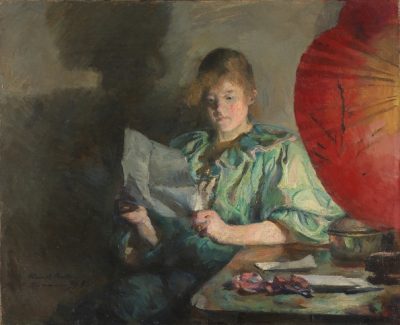
Harriet Backer (b. 1845, Holmestrand, Norway; d. 1932, Oslo, Norway); Evening, Interior; 1890; oil on canvas
Though the Nordic countries are viewed as isolated from the rest of Europe, “there are certain barriers and themes shown through a lot of the works,” explains Ottmann. Traveling across adjacent borders, a great deal of travel resulted in artists conversing and networking. Similarities in language made the trading of ideas and techniques fairly easy.
“A lot of artists also went to Paris, almost all the Nordic artists at some point went to Paris, some to London, others to Germany,” describes Ottmann, who is German.
“There is one artist in the collection, an early modernist from the Danish-German border, Franciska Clausen who was very oriented towards Germany and would go on to study and spend a lot of time with Hungarian modernist, László Moholy-Nagy in his Berlin studio. There are all these interesting interconnections.” The painting by Clausen, titled “Ladder” (1922), shows a strict, geometrical interior, reminiscent of constructionist collages by Moholy-Nagy. Influences of cubist Fernand Leger are also present in the industrial, mechanic quality of her paintings. Featured artists also include Nils Dardel, whose “The Dying Dandy” (1918) portrays fluid, floaty human figures like those of Marc Chagall’s figures.
Vivid fauvist colors excel in Tal R’s Matisse-inspired “The Drawing Class” (2014).
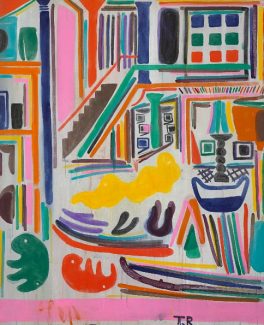
Tar R (b. 1967, Tel Aviv, Israel); The Drawing Class, 2014; pigment and rabbit-skin glue on canvas.
Such relations between artists of the eras parallel the Phillips’ contextual mission. Known for presenting the standout artists of the 19th and 20th centuries, the Phillips blends familiarity with experimentation. During their visit, guests behold Renoir and Van Gogh, then contemplate installations by contemporary artists. Such similarities continue as the permanent collection transitions to the “Nordic Impressions” exhibition space.
Fibrous, multi-colored ropes by Icelandic artist Hrafnhildur Arnardottir, better known as Shoplifter, ascend the staircase, guiding guests to the exhibition space as the furry strands spark their curiosity. Continuity, innovation, and technical and social connections between artists metaphorically evolve the gallery, as well.
Shoplifter is one of the many female artists represented in the exhibition, for approximately half of the artists selected are women. “With every exhibition, I make a point of incorporating as many women artists as possible,” says Ottmann.
As he traveled to Nordic museums, particularly the 19th and early 20th century galleries, Ottmann found the inclusion of women artists easy, for so many of their works were hanging on the walls; quite unusual as art history books primarily contain the works of men, he says. “You don’t see that very much in American museums, for example, so I was really impressed but the number of women artists hanging on the walls.”
Social equality is one of the unequivocal themes conveyed in “Nordic Impressions”. While the curated artworks convey styles and techniques of the painters, more largely do they convey deep-rooted cultural characteristics of Nordic countries. “Every man’s right” to nature is depicted in sublime landscapes, creating a “one with nature” appeal to audiences.
Melancholic portraits initially depict a cold appearance, but one that is melted when connecting with the Nordic people.
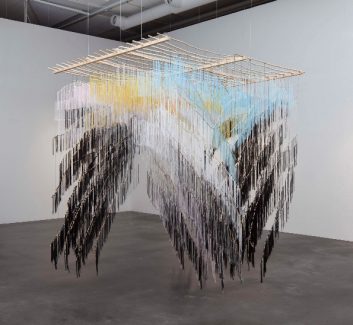
Outi Pieski (b.1973, Helsinki, Finland); Crossing Paths; 2014; wood and threads
The inclusion of indigenous Sámi people, which Ottmann credits the embassies with assuring, underlines their respect for tradition. During their visit, guests connect “red threads,” as Kosinski describes, across various medians that formulate the Nordic spirit.
Ottmann’s personal selection of artworks resembles that of Nordic diplomatic relations. As profound supporters of multilateral solutions to global challenges, the Nordic cultures utilize their rich, cultural identities and elements of their egalitarian societies to promote peaceful initiatives in a connected world. The countries’ support for the arts and the embracing nature of the Phillips forms an exhibition that welcomes audiences to new perspectives and creative styles.
“There are common threads. A specific closeness and care for nature now translate into being actively involved in global issues such as climate change, social justice, and equality that are now shown through contemporary art. These are the things that I really think are worth telling.”
“Nordic Impressions: Art from Åland, Denmark, the Faroe Islands, Finland, Greenland, Iceland, Norway, and Sweden, 1821-2018” is on view at The Phillips Collection through Jan. 13, 2018. For more information, tickets, and events, visit www.phillipscollection.org.
